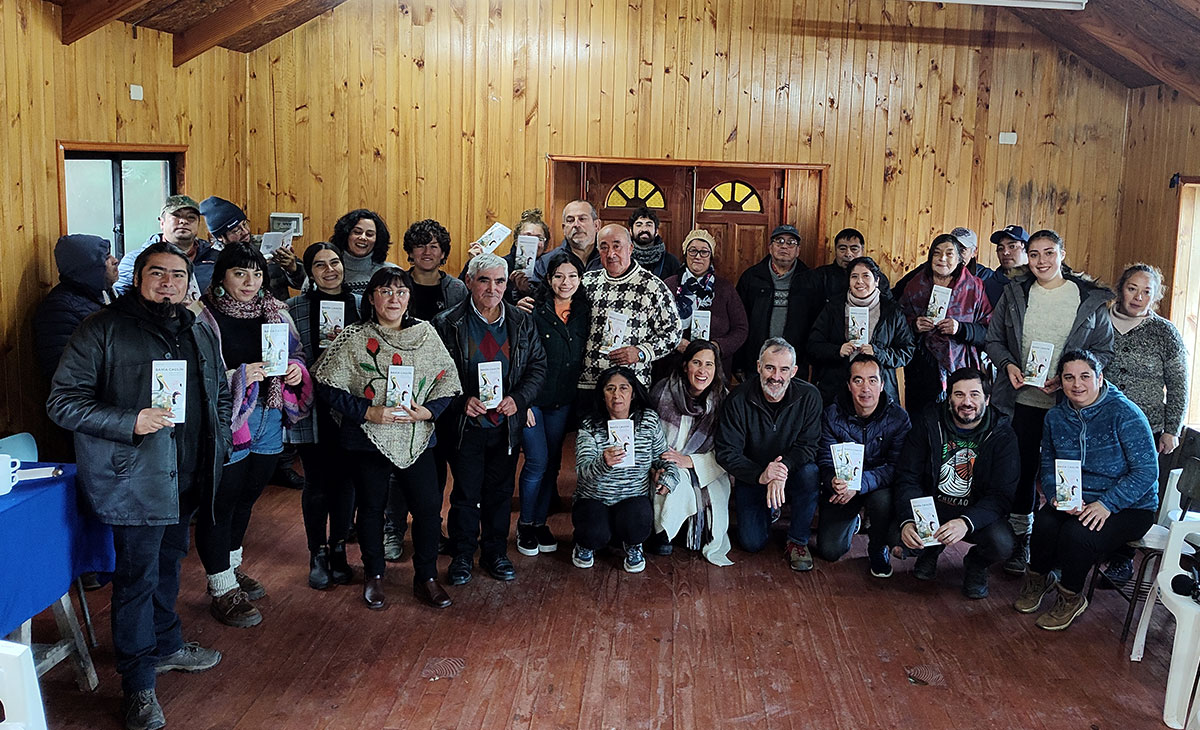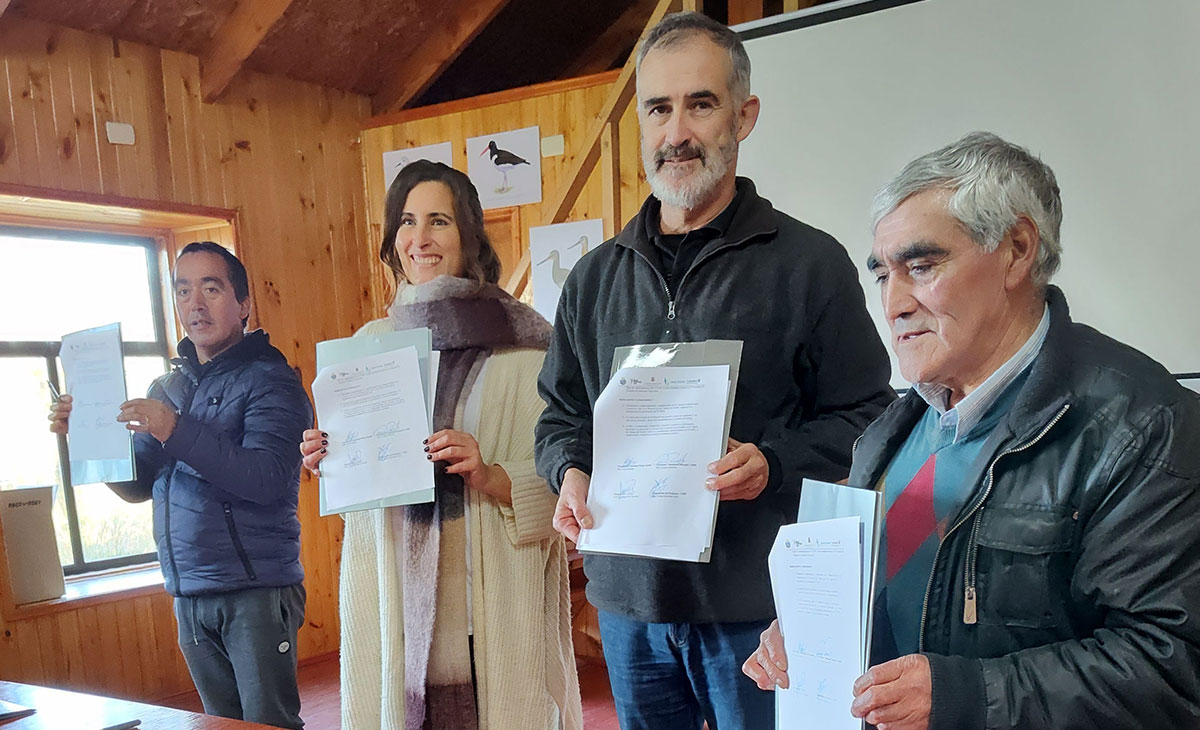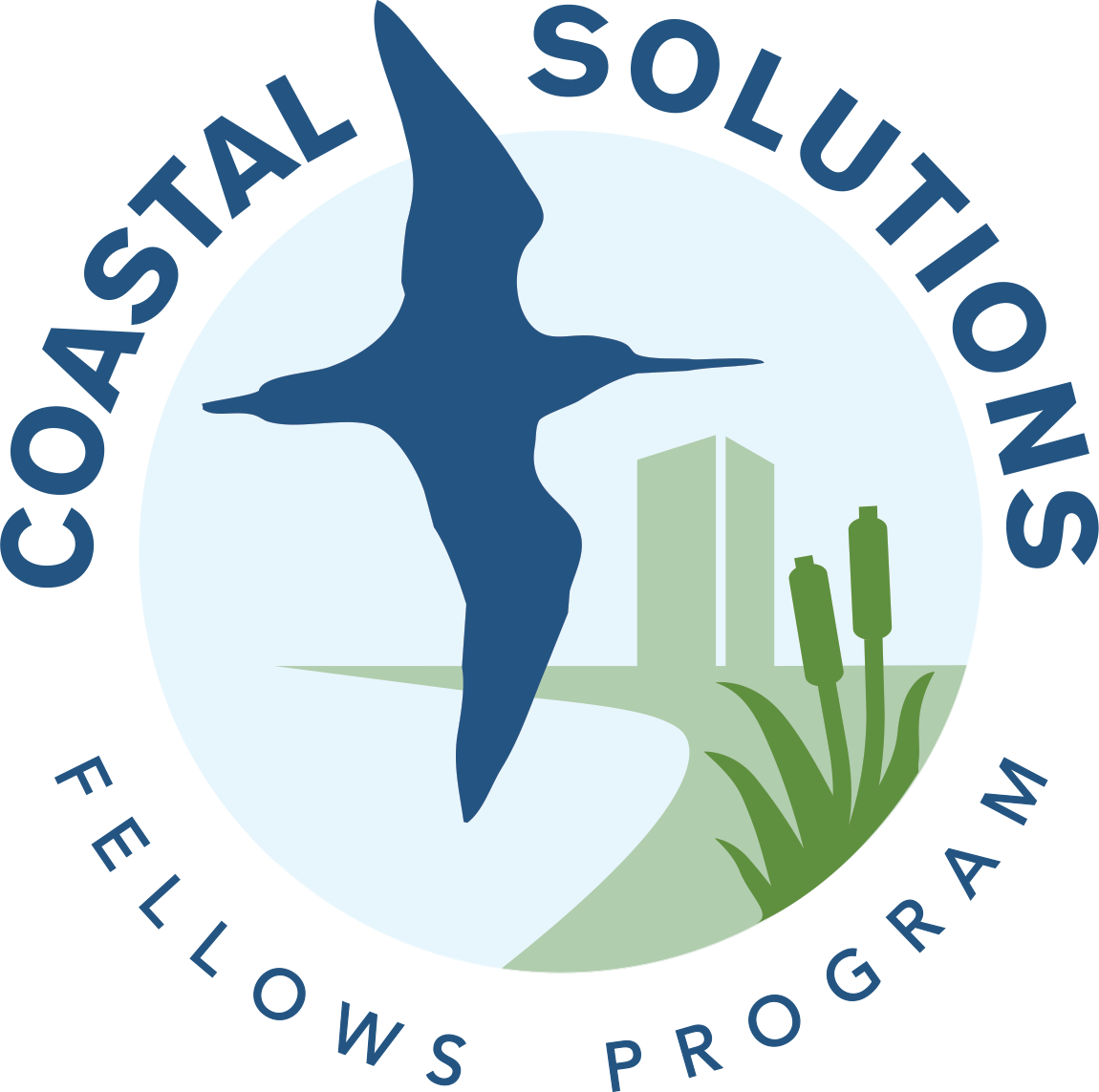Reaching Agreements to Conserve Shorebirds in Chile’s Seaweed Crops
By: Natalia Martínez Curci (CSF 2019)

In May of 2023, a coalition of partners signed the agreements to implement the “Best Practices for Shorebird Conservation in Seaweed Farms” at a pilot site in Chiloé, southern Chile. These agreements were reached following a process of collective-creation of best practices, led by the Bird Ecology Lab of the Universidad Austral de Chile (BEL), the Mapuche-Williche Wente Kaulin and Huenque Caulín communities, and the Coastal Solutions Program of the Cornell Lab of Ornithology.
The Archipelago of Chiloé is one of the most important sites for shorebird conservation in the Pacific Flyway of the Americas. It is important because it is home to tens of thousands of shorebirds and other aquatic birds, but also because it hosts significant populations of migratory species of conservation priority, such as the Hudsonian Godwit (Limosa haemastica), whose Pacific population – which breeds in Alaska – congregates almost exclusively in Chiloé during the non-breeding season.
As home to thousands of birds and paradisiacal landscapes, Chiloé offers excellent conditions for ornithological tourism and ecotourism. At the same time, a large part of the local population is economically dependent on aquaculture. This opens the door to an excellent case-study of the effects of aquaculture on shorebirds, as well as to help identify opportunities to reconcile the ecological requirements of birds with the socio-economic needs of local communities.
Since the beginning of my project with the Coastal Solutions Fellows Program in 2019, we have been supporting the research work of BEL in Chiloé, which includes the participation of many professionals in the natural sciences such as biologists, veterinarians and engineers specialized in the conservation of natural resources. After I joined BEL, an interdisciplinary team was formed to include the social dimensions in our research, and we began working to generate and integrate ecological and socio-economic knowledge that would reduce the impact of seaweed aquaculture on shorebirds.
Over the last 10 years, extensive seaweed aquaculture has shown to have one of the highest global growth rates within the aquaculture industry. Since this industry does not use fertilizers or pesticides, and the farming methods most commonly used do not permanently modify the environment, it is considered to have a relatively low impact on ecosystems compared to other forms of production. In turn, since the available scientific evidence suggests that seaweed farms increase the multi-functionality of an ecosystem, i.e. its ability to provide multiple ecosystem services, it is expected that extensive seaweed aquaculture will continue to grow and expand worldwide in the coming years.
Despite having a lower impact than other types of aquaculture production, it is important to consider that algae are ecosystem engineers. That is, they are organisms that exert significant control over the availability of resources for other biota by modulating the physical and chemical state of the environment. Therefore, if algal cultures are established in intertidal zones with no previous vegetation, they can significantly alter coastal habitats by creating more complex intertidal environments. Research conducted during this project has shown that, on an experimental scale, seaweed cultivation leads to changes in benthic invertebrate communities that influence the foraging ecology of shorebirds. Therefore, the researchers involved in the research have suggested that the establishment of seaweed farms at key shorebird sites should be planned to maintain environmental heterogeneity at the landscape scale. In other words, ensuring the persistence of uncultivated zones among the areas to be cultivated (1).


In addition to the effects of cultivation, seaweed harvesting requires the presence of large numbers of people working in the intertidal zone to collect seaweed during low tide. Since shorebirds feed on benthic invertebrates (i.e. those organisms that live at the bottom of aquatic ecosystems), they must also feed during daylight hours when the intertidal is exposed or covered with very little water. This means that algal harvesting coincides spatially and temporally with the daily feeding activities of shorebirds. Research work led by Juan G. Navedo, my mentor and director of BEL, has shown that shorebird density decreases with the increase of people and dogs in the intertidal zone. Also, birds lose a significant percentage of their daily feeding time at sites with more people in the intertidal zone. Therefore, and as a result of this work, we have suggested avoiding the presence of pet dogs on seaweed farms and keeping the number of people working in the intertidal zone below the threshold density of 1 person per 10 hectares, to avoid birds losing daily feeding time (2).
The development process of these ‘best practices’ did not rely exclusively on scientific recommendations, but it also integrated local and indigenous knowledge gathered by sociologists through semi-structured interviews. The integration of these diverse sources of knowledge laid the groundwork to begin co-constructing a ” Best Practices for Shorebird Conservation in Seaweed Farms” with seaweed producers, union leaders, indigenous community leaders and neighbors, among other relevant stakeholders. The recommendations included practices within the different stages of the process: before planting, during planting, during harvesting and during storage and drying.
Once the information was integrated, workshops and meetings were held to reach implementation agreements. The site chosen for this pilot was Caulín Bay, where thousands of shorebirds congregate every year, especially the Hudsonian Godwit; and where a large part of the community’s livelihood is based on the cultivation of a red seaweed locally known as ‘pelillo’ (Gracilaria chilensis). Caulín Bay presents a great opportunity to work on the conservation of natural resources, as a total area of 2,730 hectares was recently declared a Marine Coastal Area of Indigenous Peoples (ECMPO), in accordance with the Lafkenche Law (No. 20.249). This law grants the administration rights of these delimited coastal-marine spaces to indigenous communities that acquire, on the one hand exploitation rights, and on the other hand, the obligation to ensure their conservation through a management plan.
After a collective construction process that took four years, on May 27, 2023, these agreements were signed between the communities managing the Caulín ECMPO (Wente Kaulin and Huenque Caulín), BEL and the Coastal Solutions Program. Through these agreements, the communities committed to gradually adopt, at different stages of the process within the ECMPO, the shorebird-friendly aquaculture practices established in the ” Best Practices for Shorebird Conservation in Seaweed Farms “. The parties committed, in turn, to monitor the implementation of these following the governance mechanisms of the ECMPO, which has a working table for the coastal front. Finally, all parties also committed to evaluate the results and, if necessary, adjust management recommendations and actions within five years.
In this way, we hope that the work done in Caulín Bay can serve as a model to be scaled up to other sites in southern Chile and the world, where thousands of shorebirds coexist with seaweed production.

1. Martínez-Curci NS, Fierro P, Navedo JG. 2023. Does experimental seaweed cultivation affect benthic communities and shorebirds? Applications for extensive aquaculture. Ecological Applications: e2799.
2- Navedo JG, Verdugo C, Rodríguez-Jorquera IA, Abad-Gómez JM, Suazo CG, Castañeda LE, Araya V, Ruiz J, Gutierrez JS. 2019. Assessing the effects of human activities on the foraging opportunities of migratory shorebirds in Austral high-latitude birds. Plos One 14: e0212441.

The Coastal Solutions Fellows Program builds and supports an international community to design and implement solutions that address coastal challenges across the Pacific Americas Flyway. Our main goal is to conserve coastal habitats and shorebird populations by building the knowledge, resources, and skills of Latin American professionals, and by fostering collaborations among multiple disciplines and sectors.
